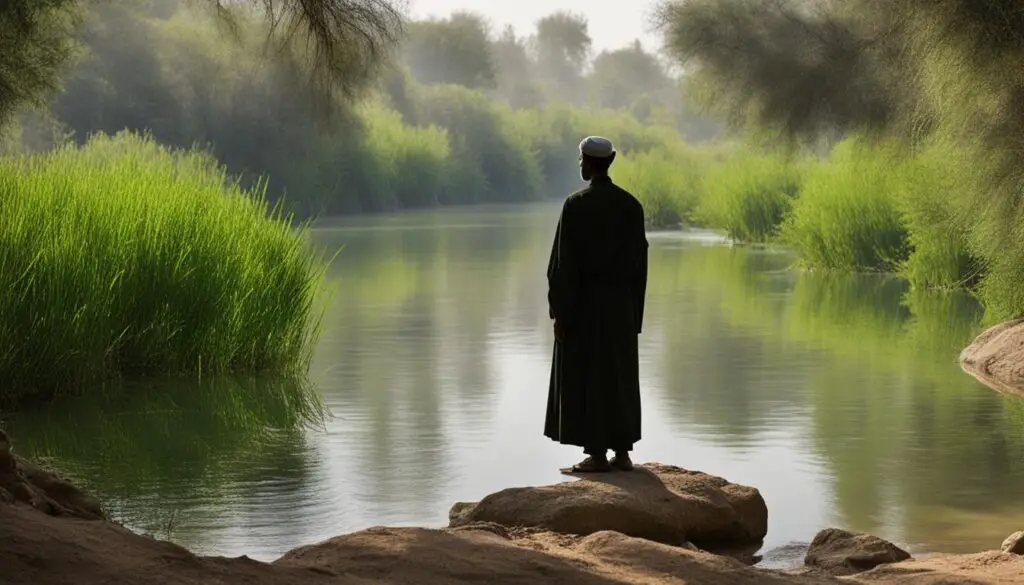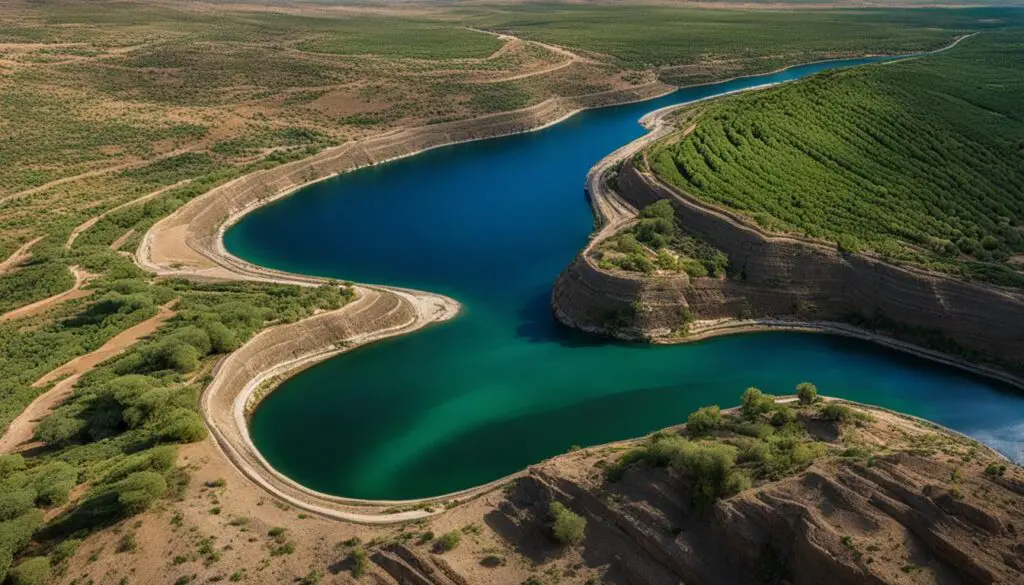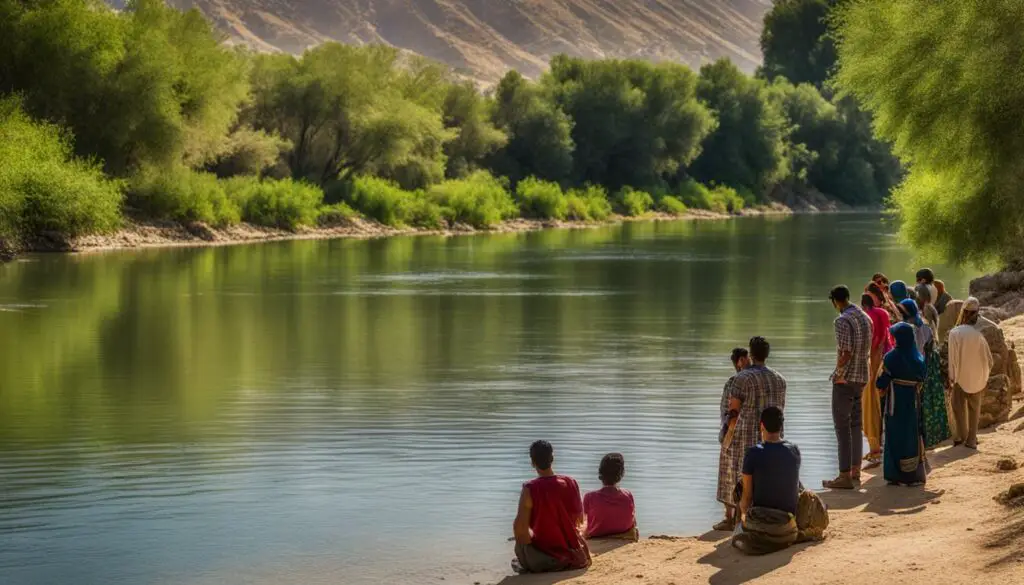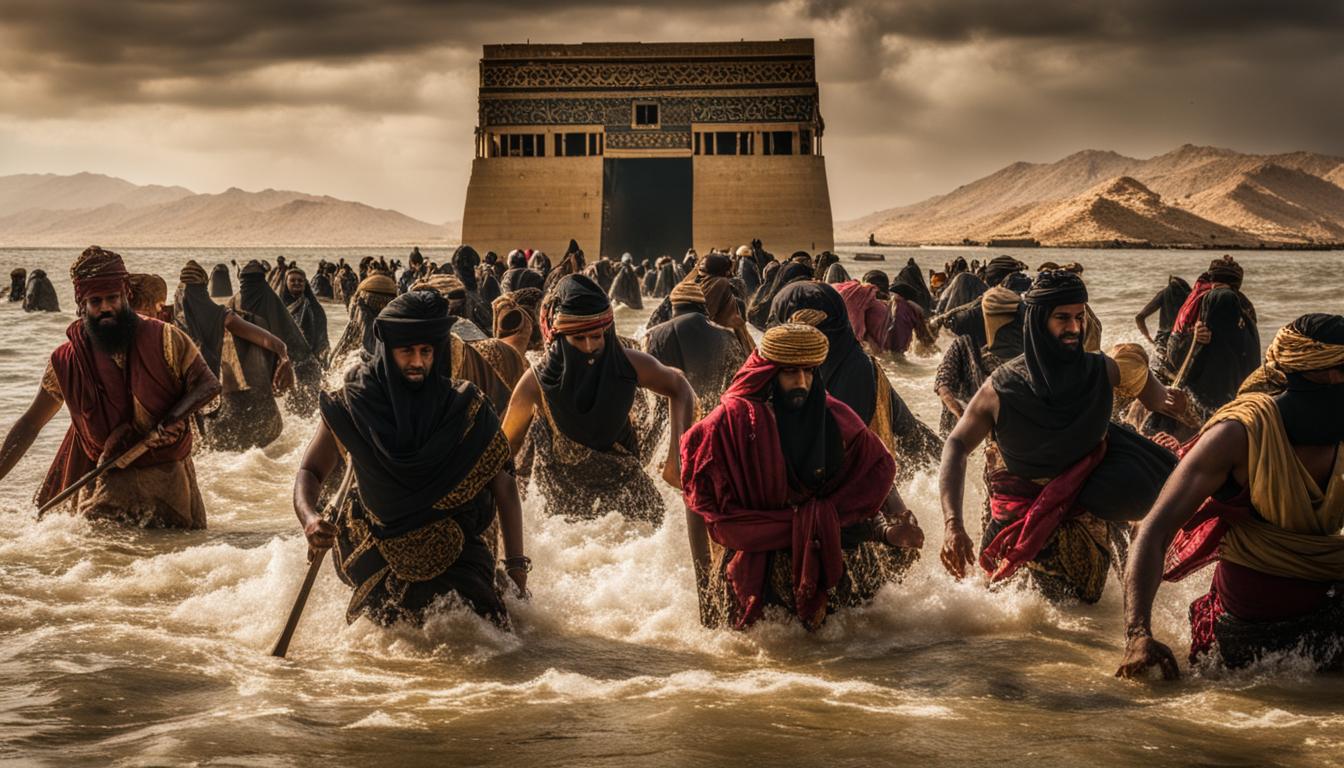The Jordan River holds great biblical significance, mentioned over 185 times in the Bible. It served as both an obstacle and a pathway for the Israelites on their journey to the Promised Land. This iconic river carries deep spiritual symbolism, representing freedom, breakthrough, and deliverance. It is associated with key events such as the crossing of the Jordan by Joshua and the baptism of Jesus by John the Baptist.
Key Takeaways:
- The Jordan River is mentioned over 185 times in the Bible.
- It symbolizes freedom, breakthrough, and deliverance.
- Events associated with the Jordan include Joshua’s crossing and Jesus’ baptism.
- The river holds deep spiritual significance for believers today.
- Visiting the Jordan River offers a chance to connect with biblical history.
The Jordan Valley in Genesis
In the book of Genesis, the Jordan Valley is mentioned as a significant location when Lot makes a crucial choice regarding the land he will inhabit. Driven by its fertility and proximity to the Jordan River, Lot decides to settle in the Jordan Valley. Unfortunately, this decision leads him to the wicked city of Sodom, which ultimately faces destruction at the hands of God.
This pivotal moment in Genesis serves as a cautionary tale, highlighting the consequences of Lot’s selfishness and the dangers of compromising one’s values for personal gain. The choice to settle in the Jordan Valley exposes Lot to the corrupt atmosphere of Sodom and ultimately results in the loss of his wife and the destruction of the city.
“But Lot’s wife, behind him, looked back, and she became a pillar of salt.” – Genesis 19:26
The story of Lot and the Jordan Valley serves as a reminder of the importance of making wise and moral choices. It illustrates the significance of discernment and staying true to one’s faith, even when faced with tempting opportunities. The Jordan Valley, in this context, represents the consequences of compromising one’s values and emphasizes the need for individuals to make decisions that align with their spiritual beliefs.
Crossing the Jordan into the Promised Land
The Israelites, led by Joshua, faced a formidable challenge as they approached the Jordan River, the final obstacle on their journey to the Promised Land. The river was at flood stage, its rushing waters presenting a seemingly insurmountable barrier. However, with unwavering faith and obedience to God’s instructions, the priests carrying the Ark of the Covenant bravely stepped into the water. And miraculously, as soon as their feet touched the river, the flowing waters came to a standstill, creating a dry path in the midst of the riverbed.
This extraordinary event marked the crossing of the Jordan and symbolized the fulfillment of God’s promise to the Israelites. It signified the end of their wilderness wanderings and the beginning of their conquest of Canaan. With the crossing of the Jordan, the Israelites embraced their destiny and embarked on a new chapter in their history, marked by victory and the establishment of their homeland.
This miraculous crossing of the Jordan River holds profound spiritual significance. It demonstrates the power and faithfulness of God to His people, showcasing His ability to open a way where there seems to be no way. It serves as a reminder that even in the face of overwhelming obstacles, God can lead us to breakthroughs and deliverance. The crossing of the Jordan is a testament to the Israelites’ trust in God’s promises and their willingness to step out in faith, even when faced with seemingly impossible circumstances.
Table: Significant Events in the Crossing of the Jordan
| Event | Description |
|---|---|
| The Ark of the Covenant Steps into the Water | The priests carrying the Ark of the Covenant, a symbol of God’s presence, step into the flooded Jordan River. As they enter the water, the flow miraculously stops, allowing the Israelites to cross on dry ground. |
| The People Cross the Jordan | With the river parted, the entire nation of Israel crosses the Jordan River, stepping on the dry riverbed. It is a pivotal moment as they leave behind their wilderness existence and enter the land of promise. |
| The Memorial Stones | Upon crossing the Jordan, Joshua commands twelve men, one from each tribe, to take twelve stones from the riverbed and set them up as a memorial at their campsite in Gilgal. These stones serve as a lasting reminder of God’s faithfulness and the miraculous crossing. |
| God’s Promise Fulfilled | The crossing of the Jordan marks the fulfillment of God’s promise to the Israelites to inherit the land of Canaan. It is a significant milestone in their history, solidifying their identity as the chosen people of God and the beginning of their conquest of the Promised Land. |
The crossing of the Jordan River is a powerful testament to God’s faithfulness, the Israelites’ trust, and the realization of God’s promises. It continues to inspire and encourage believers today, reminding us that with God, all things are possible, and even the most formidable obstacles can be overcome. The story of the Jordan’s parting serves as a timeless reminder that when we trust in God and step out in faith, He will make a way for us.
The Jordan River in the Old Testament
The Old Testament is replete with references to the Jordan River, particularly in relation to the Israelites’ battles and conflicts. The river served as a strategic location for military movements, with armies crossing it to engage their enemies. It played a significant role in the Israelites’ conquest of Canaan, providing a natural barrier and marking the entrance into the Promised Land.
Elijah and Elisha, two prominent prophets in the Old Testament, also had significant encounters with the Jordan River. Elijah famously parted the waters with his cloak, allowing him and his successor Elisha to cross on dry ground. This event marked the passing of the prophetic mantle from Elijah to Elisha and demonstrated God’s power at work.
The Jordan River’s significance in battles and as a place of miracles emphasizes its role as a symbol of divine intervention and guidance throughout the Old Testament. It stands as a testament to the faith and resilience of the Israelites and the power of God in their midst.
Significance of Jordan River in Battles
The Jordan River played a crucial role in numerous battles and conflicts in the Old Testament. It served as a natural boundary and obstacle for armies, requiring them to strategize and find ways to cross. The river’s unpredictable currents and changing water levels added an element of challenge and danger to these military endeavors.
“And as for me, behold, I am going to die in this land. Only be strong and very courageous, being careful to do according to all the law that Moses my servant commanded you. Do not turn from it to the right hand or to the left, that you may have good success wherever you go.” – Joshua 1:7
This quote from the book of Joshua highlights the importance of courage and adherence to God’s commandments in the face of battles and challenges. It serves as a reminder that the Jordan River not only symbolized a physical obstacle but also represented the spiritual and mental strength required to overcome adversity.
| Old Testament Battles | Significance |
|---|---|
| Battle of Jericho | The Israelites crossed the Jordan River and marched around the city of Jericho, which eventually led to its miraculous destruction. |
| Conquest of Canaan | The Israelites crossed the Jordan River, marking their entrance into the Promised Land and the beginning of their conquest of Canaan. |
| Battle of Gideon | Gideon led his army across the Jordan River to defeat the Midianites, relying on God’s guidance and intervention. |
John the Baptist and the Jordan River
One of the key figures associated with the Jordan River is John the Baptist. He played a significant role in the New Testament, preaching and baptizing people in the waters of the Jordan. John’s baptism symbolized repentance and served as preparation for the ministry of Jesus Christ.

John’s message of repentance resonated with people from all walks of life, drawing crowds who sought forgiveness and a fresh start. He baptized them in the Jordan River, using the water as a physical representation of their spiritual cleansing and renewal. John’s ministry and the act of baptism served as a powerful call for individuals to turn away from sin and prepare their hearts for the coming of Jesus.
H3: The Baptism of Jesus
Among those who were baptized by John in the Jordan River was Jesus Himself. Although Jesus was sinless and did not need to repent, He chose to be baptized as a way to identify with humanity and fulfill righteousness. The baptism of Jesus marked the beginning of His public ministry and signified His anointing by the Holy Spirit.
“I baptize you with water for repentance, but after me comes one who is more powerful than I, whose sandals I am not worthy to carry. He will baptize you with the Holy Spirit and fire.” – Matthew 3:11
The baptism of Jesus was a pivotal moment in His life, demonstrating His humility and obedience to fulfill God’s plan. As Jesus emerged from the waters of the Jordan, the Holy Spirit descended upon Him like a dove, and God declared, “This is my Son, whom I love; with him, I am well pleased.” This event affirmed Jesus as the Son of God and marked the beginning of His ministry of salvation and redemption.
Through the baptism of John in the Jordan River, individuals were prepared for the arrival of Jesus, and Jesus Himself inaugurated His mission on earth. The Jordan River continues to hold deep spiritual significance as a symbol of repentance, preparation, and the transformative power of God.
Symbolism of the Jordan River
The Jordan River carries deep spiritual symbolism, representing freedom, breakthrough, deliverance, and spiritual cleansing. Throughout biblical history, the river has been associated with significant events and moments of divine intervention. The act of crossing the Jordan River symbolizes freedom from oppression and the breaking of barriers.
Just as the Israelites crossed the Jordan River to enter the Promised Land, individuals can find inspiration and hope in their own lives as they face obstacles and difficulties. The river serves as a reminder that breakthroughs are possible, even in the midst of challenging situations. It signifies a new beginning and the fulfillment of God’s promises.
“When you pass through the waters, I will be with you; and when you pass through the rivers, they will not sweep over you.” – Isaiah 43:2
In addition to symbolizing freedom and breakthrough, the Jordan River represents deliverance from bondage. It is a powerful reminder of God’s faithfulness in delivering His people from oppression and leading them to a place of safety and abundance. Just as the Jordan River played a pivotal role in the Israelites’ journey, it continues to inspire believers today to trust in God’s deliverance and guiding hand.
The Spiritual Cleansing of Baptism
One of the significant moments associated with the Jordan River is the baptism of Jesus by John the Baptist. Baptism in the Jordan symbolizes spiritual cleansing and a public declaration of faith. It represents the washing away of sins and a commitment to a new way of life. The act of baptism signifies a fresh start and a deepening of one’s relationship with God.
| Symbolism of the Jordan River | |
|---|---|
| Freedom | Breakthrough |
| Deliverance | Spiritual Cleansing |
The Jordan River’s symbolism extends beyond biblical times. It continues to inspire and encourage believers to seek freedom, breakthrough, deliverance, and spiritual cleansing in their own lives. Through faith and trust in God, individuals can find hope, healing, and a renewed sense of purpose as they navigate the challenges and rivers of life.
Geography of the Jordan River
The Jordan River, one of the most significant waterways in biblical history, originates at the junction of four streams near Lake Huleh. It then flows through the renowned Sea of Galilee before making its way towards the Dead Sea. The surrounding geography of the river is characterized by hills and mountains on both sides, providing a picturesque backdrop to this ancient watercourse.
As the Jordan River meanders on its course, it encounters various tributaries, with the Yarmuk River being one of the most notable. These tributaries contribute to the river’s water volume and add to its significance. Along its path, the Jordan River also weaves through narrow gorges, rapids, and fords, creating a unique topographical landscape.
To provide a more comprehensive understanding of the Jordan River’s geography, let’s take a closer look at its key features:
Table: Key Features of the Jordan River
| Feature | Description |
|---|---|
| Source | The junction of four streams near Lake Huleh |
| Sea of Galilee | A significant body of water through which the Jordan River flows, known for its biblical associations |
| Yarmuk River | A major tributary of the Jordan River, adding to its water volume |
| Hills and Mountains | The Jordan River is flanked by hills and mountains on either side of its course |
| Rapids and Fords | The river’s path is punctuated with rapids and fords, making navigation challenging |
The geography of the Jordan River, with its diverse landscapes and unique features, adds to its historical and spiritual significance. From its humble beginnings near Lake Huleh to its ultimate destination in the Dead Sea, the river’s journey reflects the challenges and triumphs faced by the Israelites as they traversed this sacred waterway.
The geography of the Jordan River not only paints a vivid picture of its physical characteristics but also enhances its symbolism and spiritual significance. The river’s diverse terrain, from the tranquil Sea of Galilee to the tumultuous rapids and fords, serves as a metaphor for the trials and triumphs encountered on life’s journey. Exploring the geography of the Jordan River provides a deeper appreciation for its role in biblical narratives and its enduring value to believers today.

Fording the Jordan River
The Jordan River offers numerous fording places, especially during low water seasons, with approximately 60 fords identified between Lake Galilee and the Dead Sea. These fords often coincide with rapids and occur at specific points along the river’s course. In ancient times, before the construction of bridges, fording was the primary method of crossing the river, providing important access points for various routes and travel.
These fording places played a crucial role in the movement of people and goods, facilitating trade and communication between different regions. They were strategically located to take advantage of natural features, such as narrower sections with reduced river flow or areas where the riverbed was more easily traversable.
Fording the Jordan River required skill and knowledge of the river’s currents and the presence of dangerous rapids. Travelers had to carefully select the most suitable fording points to ensure a safe crossing. These crossings were often challenging, especially during periods of high water flow, when the rapids were more treacherous.

The Hazor Fording Site
One notable fording place along the Jordan River was the Hazor Fording Site, located near the ancient city of Hazor. This site provided a crucial crossing point for the major trade routes connecting Egypt, Mesopotamia, and the Mediterranean coast. Merchants and travelers would use this crossing to navigate their way through the region, transporting goods and exchanging ideas.
| Fording Site | Location | Characteristics |
|---|---|---|
| Hazor | Near the ancient city of Hazor | Strategic for trade routes |
| Abel Shittim | North of the Dead Sea | Significant for crossing to Moab |
| Beth Shean | Near the ancient city of Beth Shean | Important for trans-Jordanian trade |
These fording places offered essential connections between different regions, fostering economic growth and cultural exchange. They played a vital role in the history and development of the surrounding areas, facilitating the movement of people, goods, and ideas across the Jordan River.
Historical Significance of Jordan River Locations
The Jordan River and its surrounding areas hold significant historical importance in relation to biblical events. Many locations mentioned in the Bible have been confirmed through archaeological findings, providing visitors with the opportunity to walk in the same footsteps as Jesus. These sites offer a tangible connection to the life and ministry of Jesus and contribute to a deeper understanding of biblical history.
The archaeological evidence reveals the authenticity of these biblical locations, reinforcing their relevance and significance. Excavations have unearthed artifacts and structures that align with the descriptions found in the Bible, further validating the historical accuracy of the biblical accounts. Visitors can explore these sites and witness the tangible links to the past, enhancing their understanding and appreciation of the biblical narrative.
“Walking through the ancient streets of Jericho, one can’t help but be struck by the realization that this is the same place where Joshua led the Israelites in their conquest of the Promised Land. It’s a humbling experience to stand in the very location where biblical events unfolded thousands of years ago.”
Visiting these biblical locations also provides a unique opportunity to gain insights into the culture and customs of the time. The archaeological findings shed light on the daily lives of people during biblical times, their practices, and their interactions. This deeper understanding enriches the interpretation of the biblical texts, allowing visitors to grasp the context in which these events took place.
| Biblical Location | Significance |
|---|---|
| Bethlehem | The birthplace of Jesus, fulfilling prophecies and marking the arrival of the Messiah. |
| Nazareth | The hometown of Jesus, providing insights into His upbringing and early life. |
| Capernaum | A central location in Jesus’ ministry, where He performed miracles and taught His disciples. |
Visiting these places allows for a deeper connection to the life and teachings of Jesus, bringing the biblical accounts to life in a tangible and meaningful way.
Jordan River Today
The Jordan River continues to be a popular destination for tourists and pilgrims seeking to experience its historical and biblical significance. The river is especially renowned for its role in the baptism of Jesus and is considered a sacred site for Christians around the world. Visitors have the opportunity to witness and participate in baptismal ceremonies, immersing themselves in the rich history and symbolism of the Jordan River.
One of the most notable locations along the Jordan River is the baptism site, where Jesus was baptized by John the Baptist. This site attracts thousands of visitors each year, who come to reflect on the significant event that marked the beginning of Jesus’ public ministry. Pilgrims can also explore the surrounding area, which includes ancient ruins and archaeological sites that provide insights into the historical context of biblical events.

Conclusion
The Jordan River holds immense biblical significance, encompassing spiritual symbolism and historical importance. Throughout the Bible, the Jordan River is a symbol of freedom, breakthrough, and spiritual cleansing. It played a crucial role in pivotal events such as the crossing into the Promised Land by the Israelites and the baptism of Jesus by John the Baptist.
With its rich history and profound spiritual meaning, the Jordan River continues to captivate believers today. Its association with moments of divine intervention and life-altering decisions make it a destination for those seeking a deeper connection to their faith. The river’s symbolism of deliverance resonates with individuals looking for breakthroughs in challenging situations.
Moreover, the Jordan River’s historical importance is further solidified through archeological findings that confirm the existence of biblical locations. Visitors have the opportunity to walk in the same footsteps as Jesus and gain a deeper understanding of biblical history. This tangible connection to the life and ministry of Jesus enriches the spiritual experience for pilgrims and tourists alike.
In conclusion, the biblical significance, spiritual symbolism, and historical importance of the Jordan River make it an integral part of the Bible narrative. Its role in landmark events and its representation of freedom, breakthrough, and spiritual cleansing ensure its enduring relevance for believers seeking to strengthen their faith and connect with biblical history.
FAQ
What is the biblical significance of the Jordan River?
The Jordan River is mentioned over 185 times in the Bible and is associated with landmark events such as the crossing into the Promised Land and the baptism of Jesus. It symbolizes freedom, breakthrough, and deliverance, and holds great spiritual significance.
What is the Jordan Valley’s significance in Genesis?
The Jordan Valley is mentioned in Genesis when Lot chooses it as his share of the land, leading him to the evil city of Sodom. This choice highlights Lot’s selfishness and the consequences of his decision.
How did the Israelites cross the Jordan into the Promised Land?
The Israelites, led by Joshua, faced the Jordan River as the final obstacle on their journey. Despite the river being at flood stage, the priests carrying the Ark of the Covenant stepped into the water, and miraculously, the river stopped flowing, creating a dry path for the people to cross.
What role does the Jordan River play in the Old Testament?
The Jordan River is strategically mentioned in relation to the Israelites’ battles and disputes. It served as a crossing point for military movements, and prophets such as Elijah and Elisha performed miracles and significant acts near the river.
How is John the Baptist connected to the Jordan River?
John the Baptist preached and baptized people in the Jordan River. His baptism symbolized repentance and prepared individuals for the ministry of Jesus. Jesus Himself chose to be baptized in the Jordan by John, marking the beginning of His public ministry.
What does the Jordan River symbolize?
The Jordan River symbolizes freedom from oppression, breakthrough in challenging situations, and spiritual cleansing and renewal. It represents deliverance from bondage and serves as a reminder of God’s power and faithfulness.
What is the geography of the Jordan River?
The Jordan River begins at the junction of four streams near Lake Huleh and flows through the Sea of Galilee before reaching the Dead Sea. It is surrounded by hills and mountains, with various tributaries joining along the way.
How did people cross the Jordan River in ancient times?
Fording was the primary method of crossing the Jordan River before the construction of bridges. There are approximately 60 fords identified between Lake Galilee and the Dead Sea, often coinciding with rapids and serving as important access points for travel.
What is the historical significance of Jordan River locations?
Many locations mentioned in the Bible have been confirmed through archaeological findings, providing visitors with the opportunity to walk in Jesus’ footsteps. These sites offer a tangible connection to biblical history and contribute to a deeper understanding of the events that took place.
Can I visit the Jordan River today?
Yes, it is possible to visit the Jordan River and even be baptized in its historically significant waters. The Jordan River holds religious and cultural significance for Christians and offers a chance to experience a connection to biblical events. Visitors can explore the region, visit important sites, and participate in baptismal ceremonies.
Why is the Jordan River significant?
The Jordan River holds great biblical significance, representing freedom, breakthrough, and deliverance. Its role in landmark events and its spiritual symbolism make it an important location within the Bible and for believers today.







